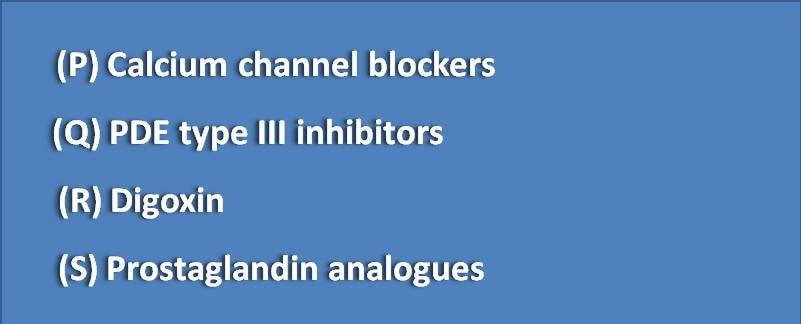- Home >
- Test papers >
MCQ on antihypertensives: Page-5

(A) Q,R and S
(B) P and Q
(C) P,Q and R
(D) P,R and S
PDE type III inhibitors like amrinone and milrinone are indicated for heart failure. PDE type V inhibitors like sildenafil are used in erectile dysfunction and pulmonary hypertension.
(A) Systemic lupus erythematosus
(B) Dry cough
(C) Ankle swelling
(D) Flushing
Hydralazine is a direct vasodilator that decreases blood pressure and perfusion pressure. Thus it produces tachycardia and an increase in renin release due to its reflex actions. The tachycardia can be controlled by betablockers like propranolol. Increased rennin release may result in sodium and water retention which is counteracted by a diuretic. Rarely, it can also produce a type II hypersensitive reaction due to immune response. Systemic lupus erythematosus is an autoimmune disorder that causes joint pains, fatigue and skin rashes.
(A) Amrinone
(B) Minoxidil
(C) Captopril
(D) Omapatrilat
AT II is an important mediator at glomerulus and it produces efferent arteolar constriction which increases GFR. ACE inhibitors and ARBs inhibit AT II synthesises and its action respectively hence effect the GFR and thereby renal functionality. Therefore these drugs are deteriorate hence contraindicated in bilateral artery stenosis where both afferent and efferent arterioles are narrowed resulting in decreased GFR.
(A) Hepatitis
(B) Hypotension
(C) Taste disturbances
(D) Heart failure
All prils produce hypotension as common side effect. Taste disturbances is only shown by captopril due to thiol group.
(A) Reserpine
(B) Amphetamine
(C) Guanethidine
(D) Doxazosin
Amphetamine is an indirectly acting sympathomimetic that displaces the noradrenaline from the storage vesicles and increases noradrenergic transmission. It is a CNS stimulant and increases central sympathetic activity.